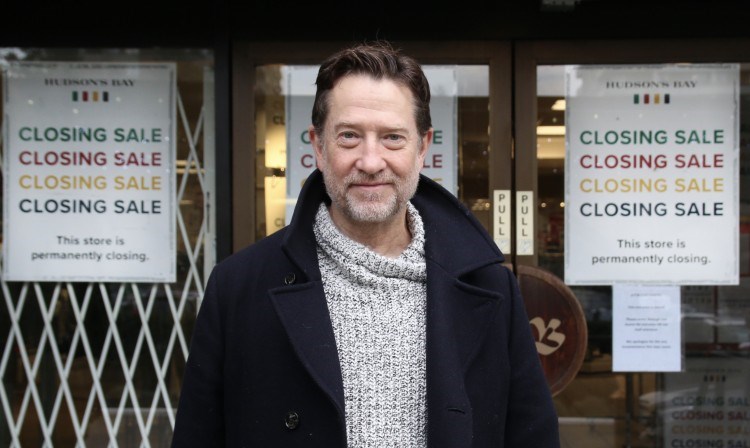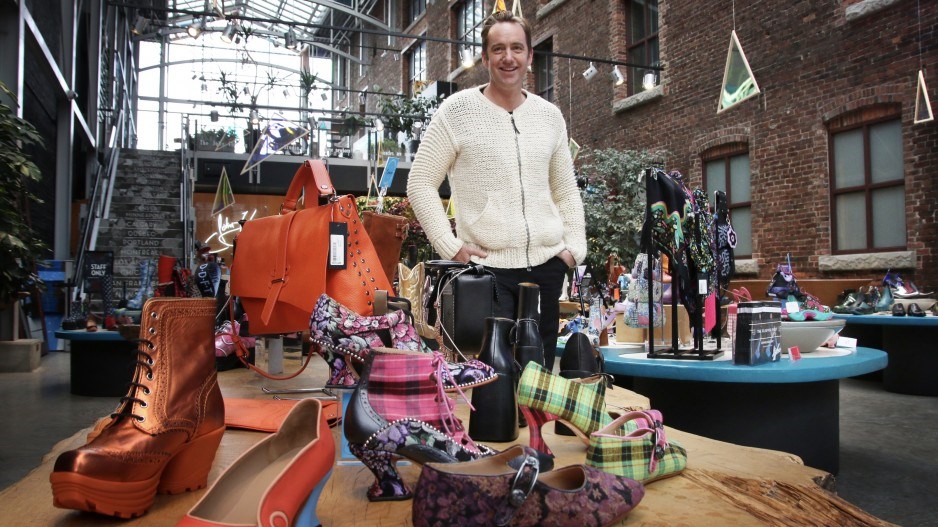Retailers are readying for an uncertain 2024, following what analysts are describing as a frugal holiday-shopping season where shoppers started buying presents earlier, are relying more heavily on discounts and are expected to make fewer purchases.
“Consumers just shut their wallets about four or five months ago,” Fluevog Shoes CEO Adrian Fluevog told BIV.
“I’m just looking to survive until 2025.”
His company expanded to 22 locations in mid-2023, when it opened a store in Sydney, Australia. Fluevog has no plans to open new stores, he said.
Aritzia Inc. (TSX:ATZ) CEO Jennifer Wong discussed what she called a “weaker retail environment” on her company’s Sept. 28 conference call.
DIG360 owner David Ian Gray told BIV he expects shoppers to cut back on spending during the holidays and into 2024 because more are feeling the impact of higher interest rates, inflation and cost-of-living increases – particularly workers who have not seen much of an increase in salary.
Consumers will have less disposable income, Gray said.
A recent Deloitte survey found consumers planned to reduce spending this holiday season by 11 per cent.
Statistics Canada data holds that B.C. retail spending rose 0.9 per cent year over year in September – a month for which the year-over-year inflation rate in the province was 3.3 per cent. That indicates shoppers were shelling out more money for fewer items, so nominal spending was up but real spending was down.
B.C. inflation then cooled in October to 2.7 per cent, but Statistics Canada has yet to release retail sales data for that month.
Gray said consumers earlier this year may not have fully realized how much their spending power would wane.
“People are going to dine out less, so I think grocery stores are going to benefit from [a frugal economic climate] at the expense of foodservice companies,” he said.
Indeed, Restaurants Canada data shows spending at eateries is nine per cent below what it was in 2019. Slightly more than half of all restaurants across the country are either losing money or are barely breaking even, according to that national organization, which advocates on behalf of restaurant owners.
Consumers could resort to theft or trading down to deal with tighter budgets
An increasing number of consumers could resort to theft, or more frequent theft, Gray said. That is likely to be a persistent challenge for retailers because there is no easy way for them to solve that problem, he added.
Executives, such as London Drugs president Clint Mahlman, have urged governments at all levels to enact laws to make streets safer and reduce brazen theft.
His store has trained staff on how to de-escalate situations with shoplifters, while also hiring extra security guards and installing high-definition surveillance cameras.
The Vancouver Police Department in October said an anti-shoplifting program that it launched in March had led to 613 arrests and them recovering $174,000 in snatched goods.
“Business owners still have concerns for their staff and customers,” acknowledged Staff Sgt. Mario Mastropieri. “We’ll continue to proactively target chronic shoplifters and violent thieves until everyone feels safe again.”
Shoppers who do not pilfer goods are likely to trade down to less expensive options.
Those who previously might have bought high-end products are likely to trade down in what they purchase – something that could help mid-tier brands such as Aritzia and Fluevog Shoes, Gray said.
Businesses like those are not seen as ones that sell opulent items but are rather in a class that is considered slightly below ultra-premium, he explained.
“Value sellers – not the cheapest ones, but ones that are a little notch down from luxury – may benefit,” he said.
The used-goods retail segment is also poised to do well, Gray added.
He pointed to Savers Value Village Inc. (NYSE:SVV) in October opening its second boutique-sized store in Vancouver, at 1062 Granville Street in the downtown core. The for-profit company’s first such boutique in the region opened at 2354 Granville Street in the South Granville neighbourhood late last year.
These stores are smaller and higher-end than full-sized Value Village stores, such as the one at 6415 Victoria Drive.
“The boutique stores are actually pretty cool,” Gray said. “It feels way nicer and really well merchandised and organized.”

Many retailers need loan relief to stay afloat
Countless B.C. small businesses, including retailers, are at risk of folding because owners accepted Canada Emergency Business Account (CEBA) loans during the pandemic.
That federal government program helped fund small businesses that were forced to close or limit operations due to public health mandates.
Businesses in the program applied for interest-free government loans up to $60,000, with the incentive being that $20,000 would be forgiven if the rest was repaid by a future date.
Prime Minister Justin Trudeau’s government recently granted a modest extension to the repayment deadline: To Jan. 18, 2024, from December 31, 2023.
Small business advocates, such as BC Restaurant and Food Services Association CEO Ian Tostenson, have called that 18-day extension “disappointing,” and are urging Ottawa to push the repayment deadline into 2025.
“Two-thirds of small businesses do not have the money to repay their CEBA loan and half of those have no capacity to borrow in order to secure the forgivable portion, said Canadian Federation of Independent Business CEO Dan Kelly.
“If a business cannot repay the loan in full by Jan. 18, their CEBA debt increases by as much as 50 per cent, creating the potential for a quarter-million business failures.”
Investing in innovation, loyalty programs are strategies for success
Gray said many retailers have stopped making large investments in technology to make their operations more efficient.
But with the rise of artificial intelligence applications, these investments could be crucial to ensure that retailers are able to compete in the coming years.
“Companies that embrace AI, and find solutions with AI, are going to be ahead of the curve, and those that don’t will be left behind,” B.C.’s Minister of Jobs, Economic Development and Innovation Brenda Bailey told BIV in October.
Businesses that finance technological upgrades are careful to target “pragmatic” needs, and to spend on things that solve specific problems, Gray said.
One example of that was Vancouver-based Lululemon Athletica Inc. (Nasdaq:LULU) CEO Calvin McDonald telling analysts on an Aug. 31 earnings call that his company planned to “launch a new performance fabric designed specifically for cold weather runs” by the end of January 2024.
“That’s pragmatic,” Gray said. “But I don’t see Lululemon doing another Mirror acquisition, or taking a flyer on that kind of thing.”
Lululemon spent US$500 million to buy home-workout equipment maker Mirror in 2020. Mirror’s marquee product was a device that appeared to be a standard mirror unless users turned it on to gain access to augmented reality.
Fitness instructors, for example, could appear, ready to guide users through workouts.
Lululemon in September announced a partnership with Peloton Interactive Inc. (Nasdaq:PTON), and said that it would no longer sell Mirror devices.
Aritzia is also investing in what Gray calls “pragmatic” technology.
Wong told analysts on her company’s Sept. 28 conference call that Aritzia recently invested to improve its e-commerce website and in-store point-of-sale systems in Canada.
Upgrades better enable shoppers to buy online and pick up merchandise in stores, she said.
“Next up is our rollout in the U.S., which is planned to begin after the holidays with completion in [the quarter that ends in February,]” Wong said.
She explained that Aritzia needed to make the investments to get more customers to buy in-store, as well as online.
“One of our biggest opportunities [that] arises from these additional services is to convert more single-channel clients to omni-channel,” she said.
“Our omni clients spend approximately three times more than clients who shop exclusively at either our retail or our e-commerce channels. In addition, the retention rate for omni clients is substantially higher than for single-channel clients. We also expect to benefit from inventory optimization.”
Gray advises retailers to be smart about what data they gather from customers and how they use it to increase sales.
Often, retailers obtain customer emails and then pump out bulk communications that are not targeted or curated based on what purchases consumers have made in the past.
London Drugs, for example, recently sent a longtime male customer – who has never purchased cosmetics – offers to get extra points if he buys a certain brand of mascara.
“Only a few loyalty programs are designed well enough to be worthwhile,” Gray said.
Retailers eye bricks-and-mortar expansion
Despite consumers cutting back on spending, many B.C.-based retailers plan to expand.
Kit and Ace CEO David Lui last month told BIV that he intends this spring to open a store on the north side of West 4th Avenue, between Yew and Vine streets.
“We will open three new stores in Metro Vancouver,” Lui said. “The other stores will be in suburbs, in malls.”
His company operates six stores, including one in Gastown. Lui’s plan is to have 10 Kit and Ace stores by the end of 2024. His other planned opening would be in Toronto, he said.
New Mountain Equipment Co. CEO Peter Hlynsky told BIV that he plans to double his company’s store count within six years.
His company operates 22 standalone stores across the country and three stores within Hudson’s Bay Co. (HBC) locations in Toronto.
Hlynsky plans to open “three to four” standalone stores per year, increase the company’s standalone store count to 40 stores by 2028 and continue to grow.
Aritzia said in a September news release that it has more than 115 stores. Its CFO, Todd Ingledew, said on his company’s Sept. 28 conference call that Aritzia planned to open six new stores in the six months that end in February. Aritzia then plans to open 11 additional stores in the fiscal year that ends in February 2025, he added.
Lululemon at the end of July had 672 stores, up a net total of 10 locations from three months earlier.
The company may reveal more about its store-expansion plans when it releases its next earnings report tomorrow (Dec. 7).
Analysts have been increasingly downbeat on Lululemon, with Wells Fargo downgrading the company's shares to equal weight from overweight on Monday (Dec. 4). Yesterday (Dec. 5), Raymond James added to the pessimism even though the investment firm is still bullish on the yogawear-maker's stock. Its downgrade was to outperform, from being a strong buy.





